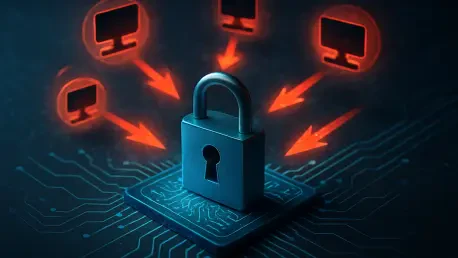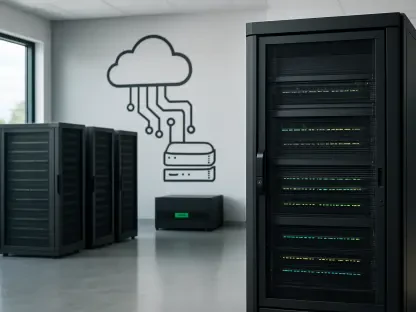Imagine a critical telecom network, responsible for emergency services and national security communications, grinding to a halt under an invisible barrage of data. This scenario is no longer a distant fear but a pressing reality as Distributed Denial of Service (DDoS) attacks surge to unprecedented levels, targeting the very backbone of modern connectivity. Recent findings from a comprehensive threat intelligence report reveal a chilling escalation in both the frequency and intensity of these cyberattacks, often exploiting millions of compromised home internet connections. With attacks now peaking at terabit-scale ranges and concluding in mere minutes, the stakes for network operators have never been higher. The urgency to safeguard these vital systems against sophisticated, fleeting disruptions has become a defining challenge for the industry, pushing the boundaries of traditional cybersecurity measures and demanding innovative, proactive defenses to protect essential services.
Rising Intensity and Speed of Cyber Disruptions
The scale of DDoS attacks on critical networks has reached alarming heights, with terabit-scale assaults becoming five times more frequent than in previous years. Often peaking between 5 and 10 terabits per second, this range is now considered the unsettling standard for such threats. These attacks are not just powerful but also remarkably brief, with 78% concluding within five minutes—a significant jump from prior trends—and 37% ending in under two minutes. This brevity poses a unique challenge, as it leaves little time for detection and response, rendering many traditional defense mechanisms obsolete. The exploitation of insecure residential endpoints, numbering around 100 million globally, fuels these massive campaigns through botnets and industrialized attack tools. For telecom operators, the rapid evolution of these threats underscores the need for real-time mitigation strategies that can keep pace with such intense and short-lived disruptions, ensuring that critical functions remain uninterrupted under pressure.
Compounding the issue is the increasing sophistication of attackers who leverage compromised Internet of Things (IoT) devices to amplify their impact. These insecure endpoints, often found in everyday households, serve as unwitting launchpads for large-scale DDoS campaigns that can overwhelm even the most robust networks. Beyond sheer volume, the strategic targeting of sensitive systems, such as subscriber data platforms and lawful interception tools, has led to severe disruptions, including the breakdown of emergency services in high-profile incidents. The brevity of attacks means that by the time a breach is identified, significant damage may already be done, with sensitive information leaked or services halted. This dynamic highlights a critical gap in current security postures, where speed of response must match the fleeting nature of modern threats. Network operators face mounting pressure to integrate advanced detection tools that can identify and neutralize these assaults before they escalate into catastrophic failures.
Systemic Vulnerabilities and Insider Risks
Beyond the immediate threat of DDoS attacks, critical networks grapple with deep-rooted systemic vulnerabilities that exacerbate their exposure to cyber risks. A staggering 76% of security flaws stem from unpatched software and application-layer weaknesses, such as inadequate access controls, which attackers exploit with alarming ease. These gaps are often widened by complex supply chains that introduce risks of credential misuse and privilege escalation, creating multiple entry points for malicious actors. The sheer scale of interconnected systems in telecom infrastructures means that a single overlooked flaw can cascade into a major breach, compromising vast swaths of sensitive data. Addressing these foundational issues requires a shift toward rigorous patch management and fortified access protocols, ensuring that every layer of the network is shielded against exploitation by increasingly adept cybercriminals.
Equally concerning is the role of insider threats, which contribute to nearly 60% of high-cost breaches through deliberate actions or unintended errors. Whether through negligence or malicious intent, insiders can bypass external defenses, exposing critical systems to significant harm. This internal risk is often magnified by the lack of comprehensive monitoring and training programs that could mitigate human error or detect suspicious behavior early. The challenge is further complicated by the evolving tactics of external attackers who infiltrate networks to target high-value assets, as seen in cases where emergency systems were disrupted. For the telecom industry, tackling insider risks demands a balanced approach that combines technological safeguards with cultural shifts, fostering accountability and vigilance among personnel. Only by addressing both external and internal vulnerabilities can network operators hope to build resilient defenses against the multifaceted threats they face.
Industry Response and Future Challenges
In response to the escalating cyber threats, the telecom industry is increasingly turning to artificial intelligence (AI) and machine learning (ML) to bolster threat detection and analytics. Over 70% of security leaders now prioritize these technologies, with more than half planning to deploy AI-based solutions within the next 18 months. These tools offer the promise of identifying patterns and anomalies in real-time, enabling faster responses to the fleeting nature of modern DDoS attacks. However, adoption is not without hurdles, as integrating AI into existing infrastructures requires significant investment and expertise. Despite the potential, there remains a critical need for these solutions to be embedded directly into network frameworks rather than treated as add-ons, ensuring seamless protection of essential services. The push toward AI-driven security reflects a broader recognition that traditional methods alone cannot keep pace with the sophistication of current cyber threats.
Yet, even as AI gains traction, other looming challenges are met with troubling complacency, particularly regarding quantum computing risks. Despite upcoming compliance deadlines in regions like the European Union, quantum security ranks low among industry concerns, leaving networks potentially unprepared for future cryptographic vulnerabilities. Additionally, the shrinking validity period of digital certificates, projected to drop to just 47 days by 2029, underscores the urgency of automated certificate management to prevent lapses that attackers could exploit. These emerging issues, coupled with persistent systemic flaws, paint a complex threat landscape that demands proactive, integrated strategies. Reflecting on past efforts, it has become evident that fragmented approaches fall short against the rapid evolution of cyberattacks. Moving forward, telecom operators must embed robust security measures into the core of their networks, prioritize emerging risks, and invest in cutting-edge technologies to safeguard critical systems against increasingly unpredictable and disruptive threats.









